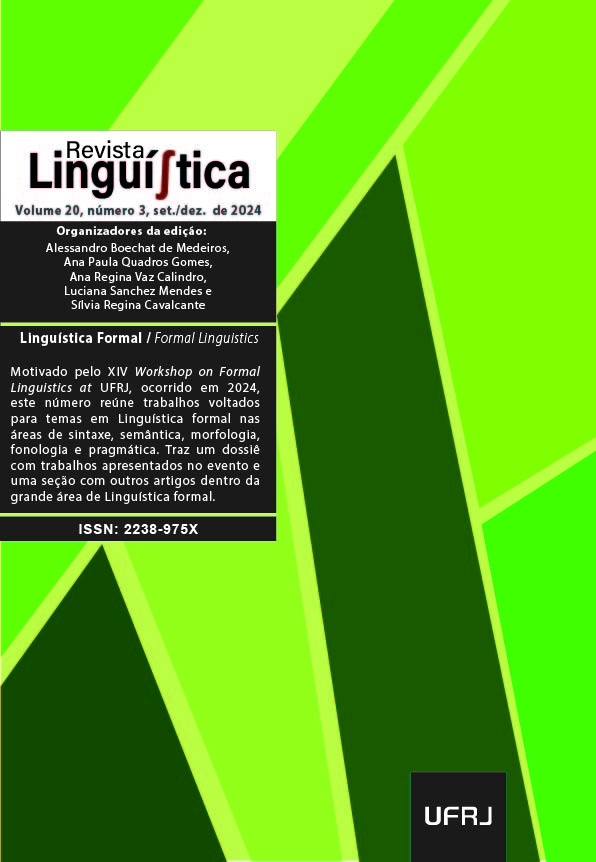Parâmetro do sujeito nulo na língua brasileira de sinais
DOI:
https://doi.org/10.31513/linguistica.2024.v20n3a65382Resumo
O Parâmetro de Sujeito Nulo (PSN) tem sido historicamente estudado por pesquisadores da teoria gerativa (Chomsky, 1981; Rizzi, 1982). Estudos recentes (Holmberg; Nayudy; Sheehan, 2009; Holmberg, 2010; Kato; Duarte, 2021) indicam que, além da marcação positiva ou negativa em relação a um determinado parâmetro, há também a possibilidade de marcação parcial. Nesse contexto, com base na Teoria de Princípios e Parâmetros (Chomsky, 1981, 1986), em estudos sobre o funcionamento dos parâmetros em ASL (Lillo-Martin, 1991), em estudos sobre a sintaxe da Libras (Quadros, 1999; Royer, 2019) e em pesquisas sobre o funcionamento do PSN (Chomsky, 1981; Rizzi, 1982), o presente trabalho discute o comportamento do PSN na Libras. Como metodologia, utilizou-se a transcrição de três vídeos de mulheres surdas em Libras. Para tanto, criou-se um vocabulário controlado (orações com e sem sujeito nulo; orações com e sem expletivo nulo; e orações com inversão de sujeito) no software ELAN. Tais transcrições produziram dados qualitativos e quantitativos, considerando que esses dados foram contabilizados e transcritos em forma de tradução e glosas para avaliação contextual. Os resultados demonstraram que a Libras se comporta como uma língua de sujeito nulo parcial, apresentando ocorrências de sujeito nulo em determinados contextos e a obrigatoriedade do sujeito explícito em outros, o que reforça essa marcação de PSN parcial. A presente pesquisa, portanto, pretende contribuir não apenas com os estudos linguísticos em geral, mas também, especificamente, com a compreensão sintática das línguas visuais-espaciais.
Palavras-chave: Parâmetro do sujeito nulo. Libras. Sintaxe. Teoria gerativa.
Downloads
Downloads
Publicado
Edição
Seção
Licença
Copyright (c) 2025 Revista Linguíʃtica

Este trabalho está licenciado sob uma licença Creative Commons Attribution-NonCommercial 4.0 International License.
Autores que publicam na Revista Linguí∫tica concordam com os seguintes termos:
Os autores mantêm os direitos e cedem à revista o direito à primeira publicação, simultaneamente submetido a uma licença Creative Commons que permite o compartilhamento por terceiros com a devida menção ao autor e à primeira publicação pela Revista Linguí∫tica.
Os autores podem entrar em acordos contratuais adicionais e separados para a distribuição não exclusiva da versão publicada da obra (por exemplo, postá-la em um repositório institucional ou publicá-la em um livro), com o reconhecimento de sua publicação inicial na Revista Linguí∫tica.

A Revista Linguí∫tica é uma revista do Programa de Pós-Graduação em Linguística da UFRJ e se utiliza da Licença Creative Commons - Atribuição-NãoComercial 4.0 Internacional (CC-BY-NC)









